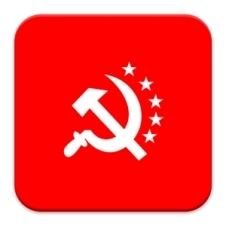Founded 22 April 1969 Ideology Marxism-Leninism | Dissolved 31 July 1972 Colours Red | |
 | ||
Founder | ||
Kavita krishnan communist party of india marxist leninist fighting caste discrimination hindu right
The Communist Party of India (Marxist–Leninist) was formed by the All India Coordination Committee of Communist Revolutionaries (AICCCR) at a congress in Calcutta in 1969. The foundation of the party was declared by Kanu Sanyal at a mass meeting in Calcutta on 22 April (Lenin's birthday).
Contents
- Kavita krishnan communist party of india marxist leninist fighting caste discrimination hindu right
- Origin
- Naxalbari uprising
- Srikakulam peasant uprising
- After 1970
- Today
- CPIMLLiberation
- Several ML factions
- Armed Group
- References
Origin
The CPI(ML) party was formed by the radicals within the Communist Party of India (Marxist) who were becoming increasingly concerned about the parliamentary politics of CPI(M). They alleged that the CPI(M) party leadership was turning towards revisionism and simultaneously a debate ensued which finally let to expulsion of the radicalised faction within the CPI(M) and led to the formation of CPI(ML). CPI(ML) advocated armed revolution and denounced participation in the electoral process. The party leaders were Charu Majumdar and Saroj Dutta, both of whom had belonged to the left-wing within CPI(M) in northern West Bengal. Kanu Sanyal, Jongol Santhal and his followers had mobilized a revolutionary peasants movement in Naxalbari, which evolved into an armed uprising of the mostly Santhal tribal inhabitants. CPI(ML) saw Naxalbari as the spark that would start a new Indian revolution, and the movement came to be known as 'naxalites'. In several parts of India, for example Uttar Pradesh, Bihar, different parts of West Bengal and in Srikakulam in northern Andhra Pradesh CPI(ML) organized guerilla units. The party got moral support from China, which actively encouraged the attempts of CPI(ML) to launch revolution.
According to Pradip Basu in his book "Towards Naxalbari(1953-1967): An Account of Inner-Party Ideological Struggle":
"There were two nuclei of radicals in the party organisation in West Bengal. One "theorist" section around Parimal Das Gupta in Calcutta, which wanted to persuade the party leadership to correct revisionist mistakes through inner-party debate, and one "actionist" section led by Charu Majumdar and Kanu Sanyal in North Bengal. The 'actionists' were impatient, and strived to organize armed uprisings. According to Basu, due to the prevailing political climate of youth and student rebellion it was the 'actionists' which came to dominate the new Maoist movement in India, instead of the more theoretically advanced sections."
Naxalbari uprising
It occurred in Naxalbari of Siliguri subdivision,Darjeeling district under the leadership of communist leaders like Charu Majumdar and others who later became the part of CPI(ML).
Srikakulam peasant uprising
In the Srikakulam district of Andhra Pradesh, communist leaders aligned themselves with the then formed AICCCR and launched peasant upsurge in Srikakulam which continued for almost 5 years in late 1960s and early 1970s.
After 1970
The first party congress was held in Calcutta 1970. A Central Committee was elected.As a result of both external repression and a failure to maintain internal unity, the movement did however degenerate into extreme sectarianism. Instead of popular armed struggle in the countryside, individual terrorism in Calcutta became a principal method of struggle.In 1971 Satyanarayan Singh revolted against the leadership, 'individual killing of people branded as class enemy' and sectarianism of Majumdar. The result became that the party was split into two, one CPI(ML) led by Satyanarayan Singh and one CPI(ML) led by Charu Majumdar. In 1972 Majumdar was killed by the police in custody, and after his death a series of splits took place during the major part of the 1970s. The naxalite movement suffered a period of extremely harsh repression that rivaled the Dirty Wars of South America at the same time that the movement got all more fragmented.
After the death of Charu Majumdar in police custody the party central committee felt apart on pro and anti Charu Majumdar CPI (M-L) openly. In December 1972 the Central Committee of the pro-Charu Majumdar CPI (ML) led by Sharma and Mahadeb Mukherjee adopted resolution to follow the line of Charu Majumdar unconditionally which others did not agree to. The pro-Charu Majumdar CPI(ML) later split into pro- and anti-Lin Biao factions. The pro-Lin Biao faction became known as Communist Party of India (Marxist–Leninist) (Mahadev Mukherjee) and the anti-Lin Biao-group later became known as Communist Party of India (Marxist–Leninist) Liberation and was led by Jauhar, Vinod Mishra, Swadesh Bhattacharya.
Today
Today, there exist a large number of political organizations whose roots are in the AICCCR/CPI(ML). Only C.P.I (M-L) faction led by Mahadev Mukherjee follows Charu Majumdar's concept of armed revolution and annihilation, whereas others have condemned the excesses of the sectarian epoch.All the organizations belonging to the later category have established legal overground structures (trade unions, student groups, peasant organisations etc.) and started participating in elections.
CPI(ML)Liberation
The Communist Party of India (Marxist–Leninist) Liberation led by Dipankar Bhattacharya and Kavita Krishnan is the largest faction of the C.P.I (M-L) that survived all twists and is now a prominent factor in national left politics of India. It has presence in mostly all parts of the country.
